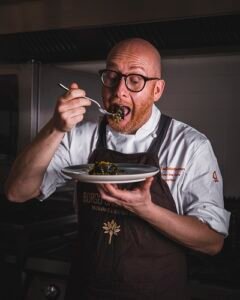Nestled in nature between Perugia and Gubbio, the Borgo Santa Cecilia estate tells the story of the wild side of Umbria with a farm, resort and restaurant.
A human essence unfolds in parallel with everyday life in the hinterland of the province of Perugia, a short distance from Gubbio, hidden among the hills aground by woods and glades. A context in which man and nature live well together: the
Borgo Santa Cecilia
is a mirror of an Umbria that still exists and remains so strongly familiar to us Umbrians that you wouldn’t want to leave.
The Village

The two owners of the hamlet, Giuseppe Onorato and Serena Sebastiani, they must have felt the same feelings when they decided to move here. We are in the high hills, 650 meters above sea level, around only 200 hectares of forest and 120 cultivated. This is not countryside, it is wilderness, it is the Wild Village.
The Wild Village is the title of the review of three gastronomic events, themed game and wild farming, held in Borgo Santa Cecilia. With the collaboration of some of the chef de Les Collectionneurs, a community of restaurateurs, hoteliers and travelers founded by Alain Ducasse of which Borgo Santa Cecilia is also a member, three “four-handed” lunches were held. The meetings involved the resident chef Alessio Pierini and, in sequence, chefs Sara Scarsella and Matteo Compagnucci of
Synthesis
*, chef Roberto Allocca of
Marennà
, chef Daniele Usai of
Il Tino
*, who dressed as “fire tamers” for a day.
A charcuterie aging cellar

Before each lunch, Giuseppe and Sabrina proudly show off the aging cellar of their own cured meats.: coppa di testa, rolled pork belly, pork salami, capocollo, lonzino, wild boar salami and sausage, and 5-year cured ham are the stars of this boutique. The memory of tastes of yesteryear is inevitably evoked, and deep expertise in the preparation of each individual product is revealed with every taste. There is feeling in the gaze of Mario, another Borgo character, as he explains to me how his world, that of hunting, works today: “We are part of a consortium of more hunting wildlife farms, accounting for about 60 percent of the total number of companies. This gives us the opportunity to share a part of the supply chain, such as meat processing, and to cut costs, becoming more competitive.”

Guest: Roberto Allocco of the restaurant Marennà
Meanwhile, in the kitchen, with Alessio Pierini and Roberto Allocco, the chefs of the second date, the game of fires and scents. The theme is the forest, and the proposals follow one another with an interesting alternation of mixed and vegetarian both in the entrée of Mushroom and Guanciale Tacos, proposed by the
Marennà
, both in that of the
Borgo
, a crescia mixed with corn, rabbit tuna and conci peppers. In the central dish, “pumpkin and kale” for the host and “barbecued quail lacquered with beef garum, potatoes under ashes and wild herbs” for the guest, Alessio’s ability to enhance the vegetable, also confirmed in the next course, the Forest Ramen, and Roberto’s skill in combining flavors with the “venison, coffee shuyu, mushrooms and berry sauce” were highlighted. Also beautiful are the subtle oriental contaminations found in the proposals of both.
On the wine side, the proposal moves between local and international, but not taken for granted. There are 150 references on the menu, all chosen by Giuseppe, who also takes care of guiding the guest to the best possible choice. The wines of the second evening were, of course, from the winery
Feudi di San Gregorio
(where the restaurant
Marennà
) starting with a Dubl Esse metodo classico bianco 2015 and rosé 2014, which accompanied the salumi and entrée, Campanaro Irpinia Doc white, Serpico Irpinia Aglianico Doc 2015, and ending with Guillelmus Taurasi Riserva Docg 2015.





